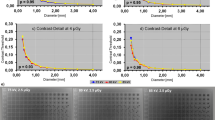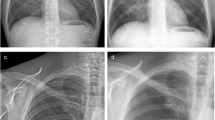Abstract
A study was conducted to compare physical and clinical system performance in digital chest radiography. Four digital X-ray modalities, two storage-phosphor based systems and two generations of a CCD-based system, were evaluated in terms of both their imaging properties (determination of presampling MTF and DQE) and clinical image quality (grading of the reproduction of anatomical details of 23 healthy volunteers using both absolute and relative visual grading analysis). One of the two storage-phosphor systems performed best in both evaluations and the first generation of the CCD-based system was rated worst; however, the other two systems were ranked differently with the two methods. The newest CCD-based system yielded a higher clinical image quality than the second storage-phosphor system, although the latter presented a DQE substantially higher than the former. The results show that clinical performance cannot be predicted from determinations of DQE alone, and that a system with lower DQE, under the quantum-saturated conditions in chest radiography, can outperform a system with higher DQE if the image processing used on the former is more effective in presenting the information in the image to the radiologist.








Similar content being viewed by others
References
Månsson LG (2000) Methods for the evaluation of image quality: a review. Radiat Prot Dosim 90:89–99
Swets JA, Picket RM (1982) Evaluation of diagnostic systems: methods from signal detection theory. Academic Press, New York
Metz CE (1986) ROC methodology in radiologic imaging. Invest Radiol 21:720–733
Swensson RG (1996) Unified measurement of observer performance in detecting and localizing target objects on images. Med Phys 23:1709–1725
Metz CE (2000) Fundamental ROC analysis. In: Beutel J, Kundel HL, Van Metter RL (eds) Handbook of medical imaging, vol 1. Physics and psychophysics. SPIE Press, Bellingham, pp 751–769
European Commission (1996) EUR 16260: European guidelines on quality criteria for diagnostic radiographic images. Office for Official Publications of the European Communities, Luxembourg
Tingberg A, Herrmann C, Lanhede B, Almén A, Besjakov J, Mattsson S, Sund P, Kheddache S, Månsson LG (2000) Comparison of two methods for evaluation of the image quality of lumbar spine radiographs. Radiat Prot Dosim 90:165–168
Sund P, Herrmann C, Tingberg A, Kheddache S, Månsson LG, Almén A, Mattsson S (2000) Comparison of two methods for evaluating image quality of chest radiographs. In: Krupinski EA (ed) Medical imaging 2000: image perception and performance, Proceedings of SPIE, vol 3981, pp 251–257
Tingberg A (2000) Quantifying the quality of medical X-ray images: an evaluation based on normal anatomy for lumbar spine and chest images. (Thesis). Lund University, Lund
Dainty JC, Shaw R (1974) Image science. Academic Press, London
Båth M, Sund P, Månsson LG (2002) Evaluation of the imaging properties of two generations of a CCD-based system for digital chest radiography. Med Phys 29:2286–2297
Hillen W, Schiebel U, Zaengel T (1987) Imaging performance of a digital storage phosphor system. Med Phys 14:744–751
Workman A, Cowen AR, Brettle DS (1994) Physical evaluation of computed radiography as a mammographic X-ray imaging system. Br J Radiol 67:988–996
Stierstorfer K, Spahn M (1999) Self-normalizing method to measure the detective quantum efficiency of a wide range of X-ray detectors. Med Phys 26:1312–1319
Dobbins JT III, Ergun DL, Rutz L, Hinshaw DA, Blume H, Clark DC (1995) DQE(f) of four generations of computed radiography acquisition devices. Med Phys 22:1581–1593
Dobbins JT III (1995) Effects of undersampling on the proper interpretation of modulation transfer function, noise power spectra, and noise equivalent quanta of digital imaging systems. Med Phys 22:171–181
Fujita H, Tsai D-Y, Itoh T, Doi K, Morishita J, Ueda K, Ohtsuka A (1992) A simple method for determining the modulation transfer function in digital radiography. IEEE Trans Med Imaging 11:34–39
The Institute of Physics and Engineering in Medicine (1997) IPEM report no. 78: Catalogue of diagnostic X-ray spectra and other data. The Institute of Physics and Engineering in Medicine, York. CD-ROM
Samei E, Flynn MJ (2002) An experimental comparison of detector performance for computed radiography systems. Med Phys 29:447–459
International Commission on Radiation Units and Measurements (1992) ICRU report 48: Phantoms and computational models in therapy, diagnosis and protection. International Commission on Radiation Units and Measurements, Bethesda
Lanhede B, Båth M, Kheddache S, Sund P, Björneld L, Widell M, Almén A, Besjakov J, Mattsson S, Tingberg A, Herrmann C, Panzer W, Zankl M, Månsson LG (2002) The influence of different technique factors on image quality of chest radiographs as evaluated by modified CEC image quality criteria. Br J Radiol 75:38–49
Miller RG Jr (1980) Simultaneous statistical inference, 2nd edn. Springer, Berlin Heidelberg New York
Månsson LG (1994) Evaluation of radiographic procedures: investigations related to chest imaging. (Thesis). Göteborg University, Göteborg
Samei E, Flynn MJ, Eyler WR (1999) Detection of subtle lung nodules: relative influence of quantum and anatomic noise on chest radiographs. Radiology 213:727–734
Samei E, Eyler W, Baron L (2000) Effects of anatomical structure on signal detection. In: Beutel J, Kundel HL, Van Metter RL (eds) Handbook of medical imaging, vol 1. Physics and psychophysics. SPIE Press, Bellingham, pp 655–682
Hoeschen C, Buhr E, Döhring W (2000) Determination of the spatial frequency limit of anatomical structures in the X-ray pattern of a thorax examination. Radiat Prot Dosim 90:109–112
Bochud FO, Valley J-F, Verdun FR, Hessler C, Schnyder P (1999) Estimation of the noisy component of anatomical backgrounds. Med Phys 26:1365–1370
International Electrotechnical Commission (1978) IEC 627/1978: Characteristics of anti-scatter grids used in X-ray equipment. International Electrotechnical Commission, Geneva
Niklason LT, Sorenson JA, Nelson JA (1981) Scattered radiation in chest radiography. Med Phys 8:677–681
Moy JP (2000) Signal-to-noise ratio and spatial resolution in X-ray electronic imagers: Is the MTF a relevant parameter? Med Phys 27:86–93
Geijer H, Verdonck B, Beckman K-W, Andersson T, Persliden J (2001) Digital radiography of scoliosis with a scanning method: initial evaluation. Radiology 218:402–410
Leitz WK, Månsson LG, Hedberg-Vikström BRK, Kheddache S (1993) In search of optimum chest radiography techniques. Br J Radiol 66:314–321
Almén A, Tingberg A, Mattsson S, Besjakov J, Kheddache S, Lanhede B, Månsson LG, Zankl M (2000) The influence of different technique factors on image quality of lumbar spine radiographs as evaluated by established CEC image criteria. Br J Radiol 73:1192–1199
Brennan PC, Devereux SA (2002) An assessment of the usefulness of screen-film speed classifications. Eur Radiol 12:1577–1583
Okamura T, Tanaka S, Koyama K, Norihumi N, Daikokuya H, Matsuoka T, Kishimoto K, Hatagawa M, Kudoh H, Yamada R (2002) Clinical evaluation of digital radiography based on a large-area cesium iodide-amorphous silicon flat-panel detector compared with screen-film radiography for skeletal system and abdomen. Eur Radiol 12:1741–1747
Dobbins JT III (2000) Image quality metrics for digital systems. In: Beutel J, Kundel HL, Van Metter RL (eds) Handbook of medical imaging, vol 1. Physics and psychophysics. SPIE Press, Bellingham, pp 161–222
Acknowledgements
The authors thank the following radiologists, technicians, engineers and physicists for their participation in the study: A. Flinck, B. Gottfridsson and U. Tylén for reading the images; L. Björneld and M. Widell for taking care of the X-ray exposures and numerous other practical matters; A. Karlsson for writing the software for the soft-copy evaluation; and M. Håkansson for characterising the grids. Many persons at IMIX ADR Oy, Fuji Photo Film and Agfa-Gevaert contributed by helping us with equipment and valuable advice.
Author information
Authors and Affiliations
Corresponding author
Appendix
Appendix
A simple analysis of the effect of using a grid can be performed in the following way: Assume that a signal S0 photons/mm2 of size A mm2 is overlaid on a homogeneous background of primary radiation B photons/mm2 and on an amount of scattered radiation R photons/mm2. The signal-to-noise ratio (SNR) of the signal without a grid can then be expressed as:
If the grid is characterised by a transmission of primary radiation of Tp and a transmission of scattered radiation of Ts, the SNR of the signal with the grid becomes:
Combining Eqs. (7) and (8) and writing B/R=K leads to a relative increase in the SNR for the object when the grid is used by an amount:
The determined values of Tp and Ts were 0.705 and 0.131 for the IMIX/IMIX 2000 grids, 0.627 and 0.095 for the Agfa grid and 0.643 and 0.120 for the Fuji grid. The scattered fraction (SF) can be written as (neglecting the influence of the signal):
which leads to a relationship between K and SF given by:
A value of 0.90 for the scattered fraction leads to a K value of 0.11, which, if inserted into Eq. (9), leads to values of ΔSNR,rel of 0.63 for the IMIX/IMIX 2000 and Agfa grids and 0.55 for the Fuji grid. Using SF values of 0.50 and 0.60 for the calculations and averaging the results leads to values of ΔSNR,rel of 0.13 for the IMIX/IMIX 2000 grids, 0.09 for the Agfa grid, and 0.08 for the Fuji grid.
Rights and permissions
About this article
Cite this article
Sund, P., Båth, M., Kheddache, S. et al. Comparison of visual grading analysis and determination of detective quantum efficiency for evaluating system performance in digital chest radiography. Eur Radiol 14, 48–58 (2004). https://doi.org/10.1007/s00330-003-1971-z
Received:
Revised:
Accepted:
Published:
Issue Date:
DOI: https://doi.org/10.1007/s00330-003-1971-z




